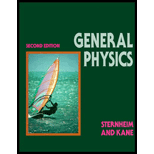
(a)
The energy difference between
(a)
Answer to Problem 37E
The energy difference is
Explanation of Solution
Write the expression for the energy of the
Here,
Conclusion:
Substitute
Substitute
Evaluate the difference between
Thus, the energy difference is
(b)
The energy difference between
(b)
Answer to Problem 37E
The energy difference is
Explanation of Solution
Write the expression for the energy of the
Here,
Conclusion:
Substitute
Substitute
Evaluate the difference between
Thus, the energy difference is
Want to see more full solutions like this?
Chapter 28 Solutions
General Physics, 2nd Edition
- An electron is trapped in a one-dimensional region of length 1.00 x 10-10 m (a typical atomic diameter). (a) Find the energies of the ground state and first two excited states. (b) How much energy must be supplied to excite the electron from the ground state to the sec- ond excited state? (c) From the second excited state, the electron drops down to the first excited state. How much energy is released in this process?arrow_forwardAssume that an atomic nucleus can be thought of as a three-dimensional box with a width of 2 x 10^-14 m. If a proton moving as particles in this box, specify : The energy of the base state of the proton in MeVarrow_forwardElectrons are fired at a rectangular potential energy barrier, once every 149 ms. If the barrier is 2.55 nm thick and has a height that exceeds the energy of the incident electrons by exactly 712 meV, how long on average would you expect to wait for one electron to pass through the barrier?arrow_forward
- One of the bound states of positronium has a lifetime given in natural units by T = 2/mas where m is the mass of the electron and a is the fine structure con- stant. Using dimensional arguments introduce the factors ħ and c and determine T in seconds.arrow_forwardOne can now use integrated-circuit technology to manufacture a "box" that traps electrons in a region only a few nanometers wide. Imagine that we make an essentially one-dimensional box with a length of 3 nanometers. Suppose we put 10 electrons in such a box and allow them to settle into the lowest possible energy states consistent with the Pauli exclusion principle. a) What will be the value of the highest energy level occupied by at least one electron? b) What will be the electrons' total energy (ignoring their electrostatic repulsion)? c) How would your answers to the above be different if the electrons were bosons instead of fermions? d) What is the wavelength of the lowest energy photon that can be absorbed (the electrons in this box are fermions)?arrow_forwardAssume that the nucleus of an atom can be regarded as a three-dimensional box of width 2·10-14 m. If a proton moves as a particle in this box, find: (a) The ground-state energy of proton in MeV. (b) The energies of the first and second excited sates. (c) What are the degenerates of these states?arrow_forward
- What is the kinetic energy of each electron in a beam of electrons if the beam produces a diffraction pattern of a crystal which is similar to that of a beam of 1.00 eV neutrons? (knowing that electron mass is 9.11*10^-31 kg and neutron mass is 1.67*10^-26 kg). What are the specific equations that are being used in this problem?arrow_forwardAn alpha particle of mass 3727.4 x 106 eV/c² is trapped in a box of size L = 0.000001 nm = 106 nm (the size of a nucleus). Treat this as a 1D infinite square well. Find: (a) The n = 5 wavefunction and probability density. Draw a graph. (b) The ground state energy and first excited state. (c) The wavelength of a photon emitted when the alpha particle transitions from the first excited state to the ground state. [Note that wavelengths between 0.001 nm to 10 nm are x rays and less than 0.001 nm are gamma rays.] (d) The probability that the alpha particle is in the range x = 0 to x = 2/5L for the n= 5 state. (e) The expectation value of the position of the alpha particle for then=5 state. If by inspection, explain.arrow_forwardThe uncertainty in a particular short-lived nuclear excited state is 1.8 eV. What is the smallest lifetime, in seconds, that this state can have?arrow_forward
- A nanoparticle containing 6 atoms can be modeled approximately as an Einstein solid of 18 independent oscillators. The evenly spaced energy levels of each oscillator are 5e-21 J apart. Use k = 1.4e-23 J/K. When the nanoparticle's energy is in the range 5(5e-21) J to 9(5e-21) J, what is the approximate heat capacity per atom?arrow_forwardIn solid helium the spacing between atoms is about 3Å . Helium contains 2 protons and 2 neutrons, so the mass of a helium atom is 6.6×10−27 kg. What is the smallest possible energy of a helium atom in solid helium? What temperature (in Kelvin) does this energy correspond with? (Boltzmann's constant is kb=1.38×10−23 J/Karrow_forwardIn how many different configurations can four particles be distributed over a set of evenly spaced energy levels (AE=ɛ) such that the total energy is 4ɛ? Select one: а. 8 b. 11 С. 5 d. 3arrow_forward
 Modern PhysicsPhysicsISBN:9781111794378Author:Raymond A. Serway, Clement J. Moses, Curt A. MoyerPublisher:Cengage Learning
Modern PhysicsPhysicsISBN:9781111794378Author:Raymond A. Serway, Clement J. Moses, Curt A. MoyerPublisher:Cengage Learning
